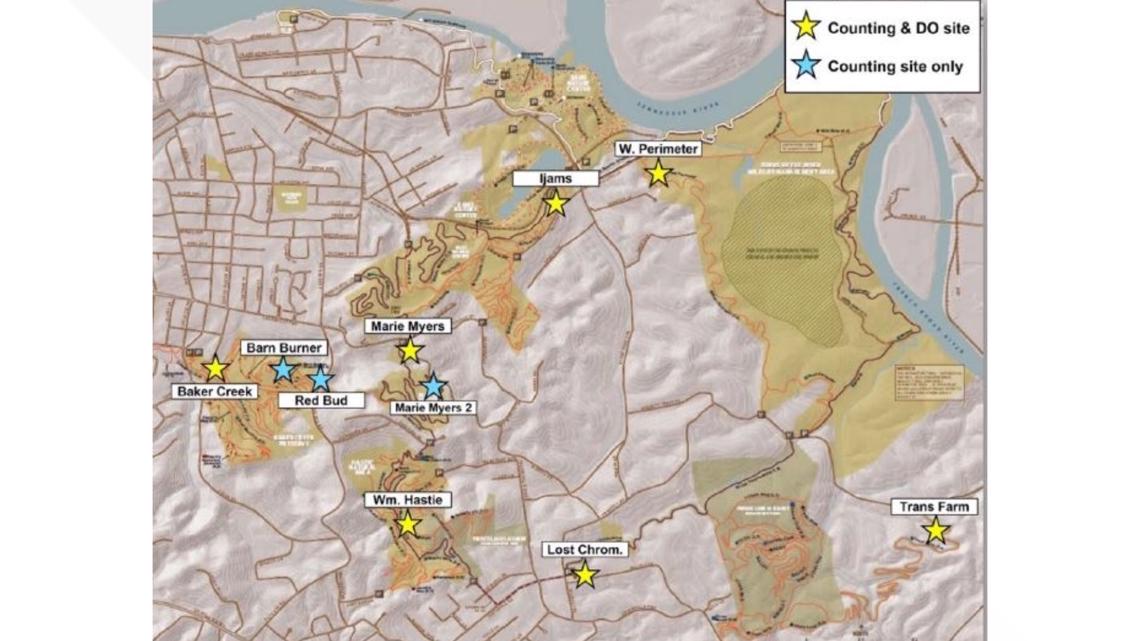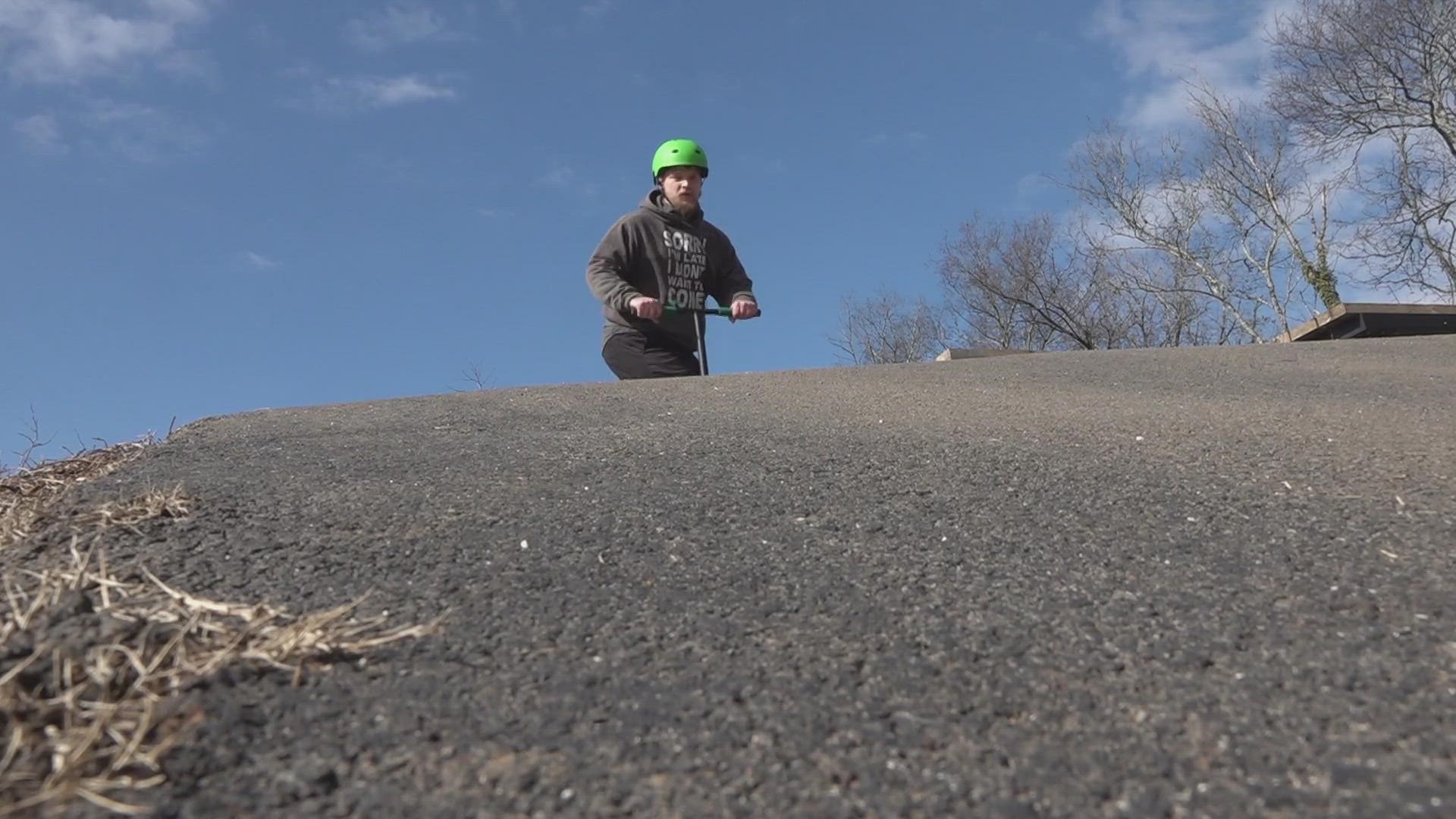KNOXVILLE, Tenn. — One of the most popular outdoor areas in East Tennessee is the Knoxville Urban Wilderness. The network of 50 miles of greenways connects through 1,000 acres of green space and forestry in South Knoxville.
It was created almost a decade ago through a partnership that includes the city, county, and state in addition to non-profits like Legacy Parks Foundation, Appalachian Mountain Bike Club, and the Aslan Foundation. The Urban Wilderness is situated just minutes outside downtown Knoxville, making it accessible to many in the Knox County area and beyond.
It's loved by locals and travelers, alike.
"We've enjoyed these trails immensely. We took a boardwalk going near the river and the caves. It's a very nice park. It's been a great experience, said Harvey Internet.
He was visiting the Knoxville area and Ijams Nature Center with his wife, Janet.
Ricky Poole is a local. He is a regular at the Baker Creek Reserve, which has bike jump racks.
"This is an awesome place where a lot of young kids and a lot of adults come out and right on. I'm running on a scooter. But a lot of people come out here right on like bikes and skateboards and have seen a few rollerbladers out here, and everyone just comes out here to have fun. It's a really nice place. It's awesome," Poole said.
The outdoor area's quick rise in popularity intrigued researchers at the University of Tennessee, particularly the space's community reach, economic impact, and physical impact on the people of Knoxville.
Gene Fitzhugh is one of the people whose interest was piqued by the project. He is an assistant professor of Kinesiology, Recreation, and Sports Studies at the University. He helped with a 2015 study that looked into the park's projected economic impact on the surrounding community.
Now, Fitzhugh is embarking on a journey with a team of other people to learn more.
"We wanted to know... because it is such a very unique feature of the city of Knoxville, who's using this trail system? How many people are using it? And who are they? What do they look like," Fitzhugh said.
Researchers just completed part one of a two-year comprehensive study of Knoxville’s Urban Wilderness to show the demographic breakdown of users.
In 2021, the report shows roughly 304,000 people were estimated to have used the KUW trails. Bakers Creek was by far the most popular location with more than 111,000 yearly users. Ijams was the second most popular trail location with more than 70,000 users. The trail that got the least amount of use was Marie Myers Sevier, which only had about 3,000 people use it last year.


The map above shows the spread of those trails throughout the KUW. The stars on the map represent 'counting sites.' The blue stars are sites that have infrared trail counters, and the yellow star sites have both infrared and direct observation counters.
"We spent two years observing people, we observed over 3,000 people on the trails. And in the bike park," Fitzhugh said.
The next set of data collected by researchers is the demographic profiles that make up people who use the trails and bike parks.
Approximately seven out of 10 people using both the trails and bike park were men. The trail with the highest percentage of women was at Ijams. Women make up nearly half of the people that visit that area, the report said.
The UT report said the predominance of men on the trails is to be expected.
"This is not surprising in that recent reports have indicated that eight out of 10 mountain bikers and six out of 10 trail runners are males," the report said.
More adults are using walking and biking trails than children. On the trails, 83.7% of users are adults between the age of 18 to 65 years old. Only 54% of people who use the bike park at Baker Creek Preserve were considered adults, the report said.
Urban Wilderness users are also predominately white. White people make up 95% of the users on the trails and 94% of the population uses biking trails. Black people make up just 2% of users on the trails and at bike parks, and the Latino population makes up 1.3% of users on the trails and 2.6% of users at the bike park.
"The diversity or the lack of diversity was very noticeable. And it's something we're really starting to put attention towards in terms of why aren't people of color coming to the Knoxville urban wilderness," Fitzhugh said.
The area surrounding the Urban Wilderness has a much higher population of people of color. The report dived into why those communities may not be accessing the trails.
According to the "Black Faces, White Spaces" study, which was cited in the Urban Wilderness study, "African Americans, the largest minority population in Knoxville, are less likely to visit forest environments similar to the KUW because of perceived threats from wildlife and other humans," the report said. "Perhaps the structure and design of the KUW is not perceived as a safe place to visit and recreate."
In addition, the report cited social media as being a deterrent for communities of color.
"Social media has historically used few images of people of color in nature and outdoor recreation spaces, which may limit feelings of inclusion and welcoming," the report said.
"It's one of the big things with our study that we think will help the city will help everyone figure out how we can make this urban wilderness attracted to everyone and doesn't matter where you live," Fitzhugh said.
The report is the first of its kind in the nation, Fitzhugh said. It helps not only the people of Knoxville better understand the impact of the greenway system, but also other parks across the country.
This is the first in a series of reports the University of Tennessee is conducting into the Knoxville Urban Wilderness.
For more information, you can download the report here.
To learn more about how you can enjoy the Knoxville Urban Wilderness, click here.

